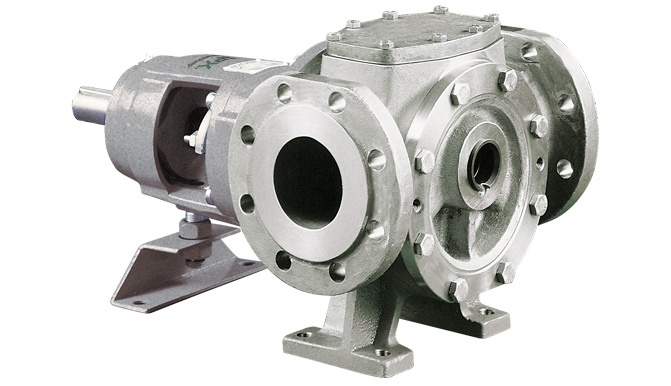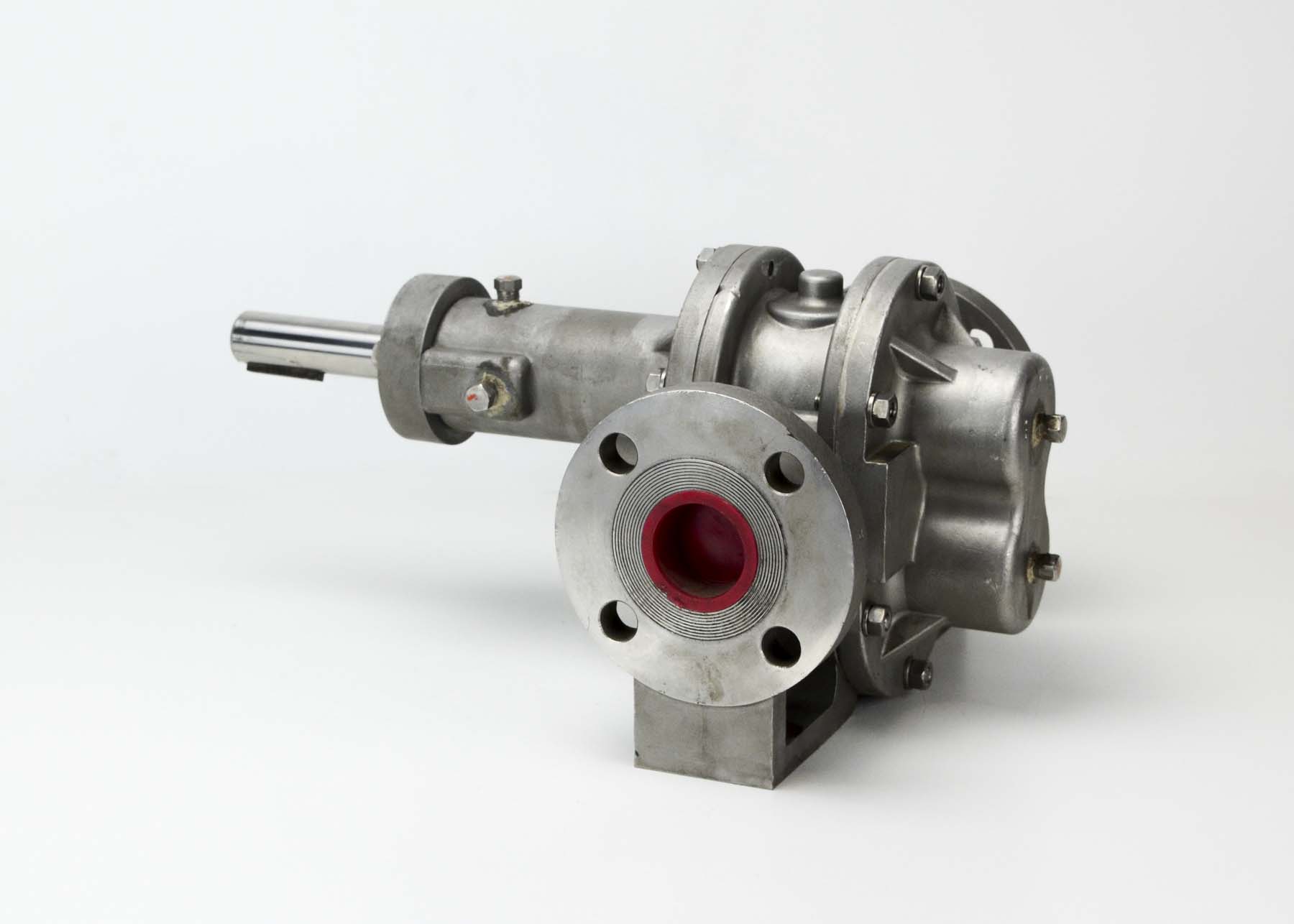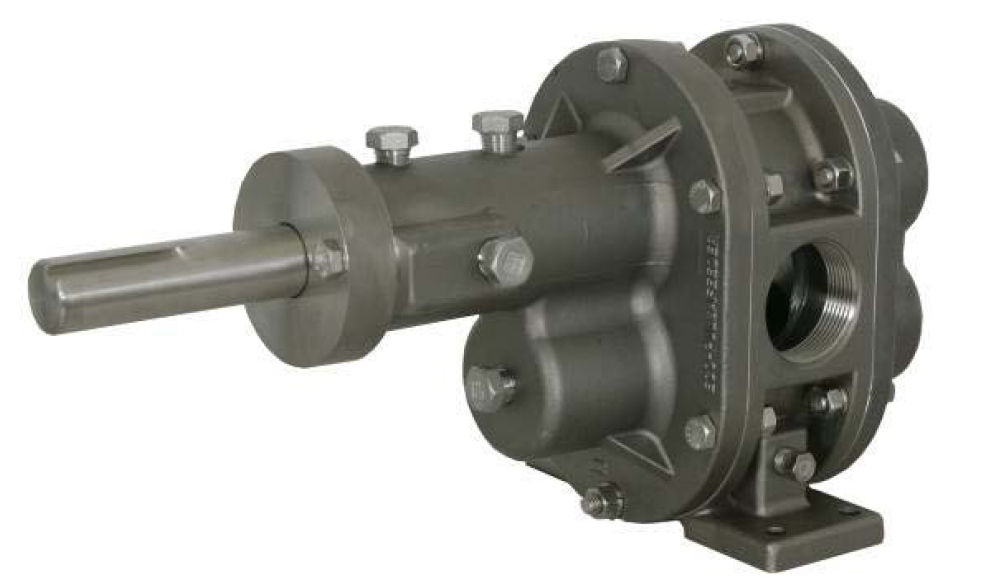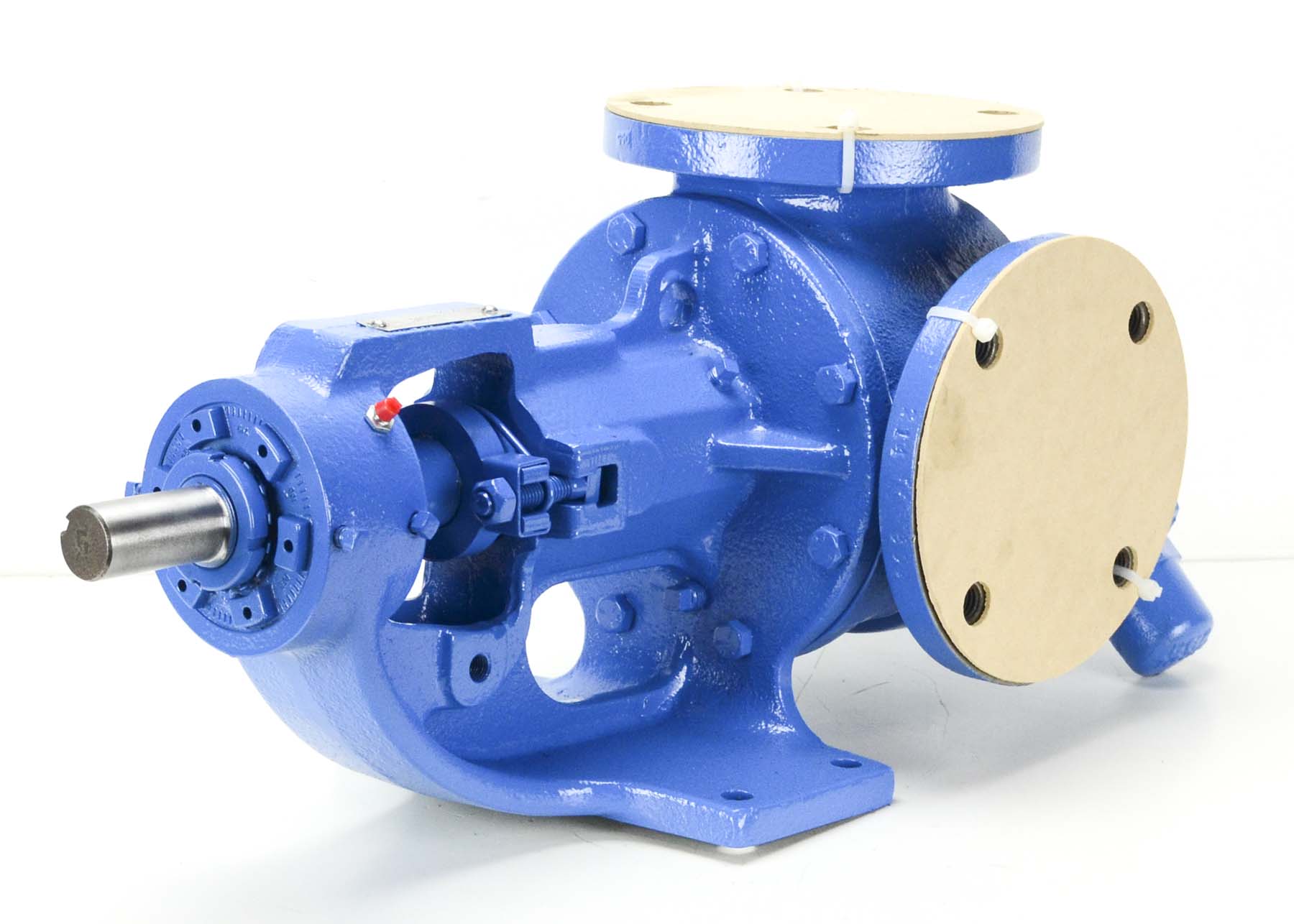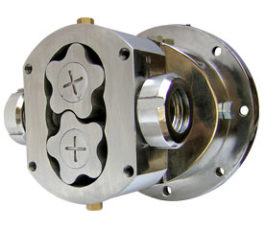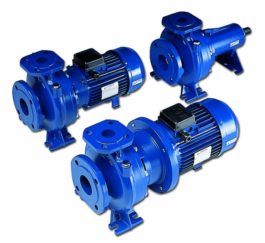Rotary Gear Pumps
$ 2,125.00 – $ 6,879.00Price range: $ 2,125.00 through $ 6,879.00
Gear pumps are positive displacement pumps that efficiently move fluids by utilizing the rotation of gears. These pumps consist of two meshing gears, typically an external gear and an internal gear, housed within a casing. As the gears rotate, they create cavities that trap and transport fluid from the inlet to the outlet, producing a steady and consistent flow.
Gear pumps are renowned for their ability to handle various types of fluids, including viscous liquids and slurries, making them ideal for applications in industries such as chemical processing, oil and gas, and hydraulic systems. Their robust construction and simplicity in design contribute to their durability and reliability in demanding environments.
One of the key advantages of gear pumps is their ability to provide precise flow rates and high pressure, thanks to the controlled movement of the gears. They are also valued for their compact size and ease of maintenance, which involves regular checks of lubrication, seals, and internal components to ensure optimal performance. Overall, gear pumps offer a reliable solution for fluid transfer needs, combining efficiency with durability for a wide range of industrial applications.
Description
Rotary Gear pumps are widely used in various industrial and engineering applications due to their simplicity, reliability, and efficiency in moving fluids. Additionally, these pumps use meshing gears to transfer mechanical energy to the fluid, creating a smooth and continuous flow. Finally, this detailed overview explores the operation, types, advantages, disadvantages, and applications of them.
Working Principle
Gear pumps operate on a straightforward principle: Rotating gears create a positive displacement of the fluid. The key components include:
- Gears: Typically, two or more gears mesh together within a casing.
- Casing: Encases the gears and directs the flow of the fluid.
- Inlet and Outlet Ports: Allow fluid to enter and exit the pump.
When the gears rotate, they create a vacuum at the inlet port, drawing fluid into the pump. Furthermore, as the gears mesh and rotate, they trap and transport the fluid between the gear teeth and the casing. In addition, this process pushes the fluid towards the outlet port, creating a continuous flow. The mechanical energy from the rotating gears is thus converted into fluid movement.
Types of Gear Pumps
External Gear Pumps
Externals feature two gears that rotate in opposite directions. Moreover, the gears are mounted on separate shafts, which are housed in the pump casing. Furthermore, key characteristics include:
- Operation: One gear drives the other, with the fluid being drawn into the space between the gear teeth and the casing.
- Applications: Suitable for transferring high-viscosity fluids, such as oils and lubricants, due to their robust design.
- Advantages: High efficiency, good for continuous and consistent flow.
Internal Gear Pumps
Internal consists of an inner gear that rotates within a larger outer gear. In addition, the gears mesh together to create the fluid movement. Key characteristics include:
- Operation: The inner gear is driven by an external shaft, and the fluid is transported between the gears and the casing.
- Applications: Ideal for handling fluids with varying viscosities and those containing suspended solids.
- Advantages: Provides a smooth, pulsation-free flow and can handle a broader range of fluids.
Rotary Gear Pumps
They are a subset of external and internal that use rotating gears to move the fluid. They can be designed as either external or internal types but focus on rotary motion.
Conclusion
Gear pumps are a versatile and reliable choice for many fluid handling applications. Also, their simple design, high efficiency, and consistent flow make them suitable for a wide range of industries, including automotive, oil and gas, chemical processing, food and beverage, pharmaceutical, and water treatment. While they offer numerous advantages, including durability and versatility, they also come with limitations such as limited self-priming capability and potential wear. Understanding these factors and performing regular maintenance ensures that gear pumps continue to deliver optimal performance and reliability in various industrial settings.
Other pumps you may be interested in:
Centrifugal Pumps
Lobe Pumps
Vacuum Pumps
Specifications
Gear pumps are engineered to deliver consistent and reliable fluid transfer across a variety of applications. Below are the detailed specifications commonly associated with gear pumps:
General Specifications
- Type: External Gear Pump / Internal Gear Pump / Rotary Gear Pump
- Material:
- Housing: Cast iron, steel, stainless steel, or aluminum
- Gears: Steel, stainless steel, or bronze
- Seals: Fluorocarbon, nitrile, EPDM, or Viton
- Pump Design: Positive displacement, rotary motion
Performance Specifications
- Flow Rate:
- Range: 0.1 to 10,000 gallons per minute (GPM) or 0.4 to 37,850 liters per minute (LPM)
- Accuracy: Typically, ±1% of the full-scale range
- Pressure Rating:
- Maximum Pressure: Up to 6,000 psi (415 bar)
- Typical Operating Pressure: 100 psi to 1,500 psi (7 to 100 bar)
- Temperature Range:
- Minimum Temperature: -40°F (-40°C)
- Maximum Temperature: 400°F (204°C)
- Viscosity Range:
- Low Viscosity: 1 centipoise (cP)
- High Viscosity: Up to 1,000,000 cP
Dimensional Specifications
- Size:
- Inlet/Outlet Ports: Typically range from 1/4 inch to 12 inches in diameter
- Dimensions: Vary based on pump size and type
- Weight: Typically ranges from 5 lbs. (2.3 kg) to 500 lbs. (227 kg), depending on the size and material
Material Specifications
- Pump Body:
- Cast Iron: Suitable for general industrial applications
- Stainless Steel: Corrosion-resistant, used in food, pharmaceutical, and chemical industries
- Aluminum: Lightweight, used in less corrosive environments
- Gears:
- Steel: For standard applications
- Stainless Steel: For corrosive or high-purity applications
- Bronze: For applications requiring wear resistance
Mechanical Specifications
- Gear Type:
- External Gears: Two gears meshing externally
- Internal Gears: An inner gear rotating within an outer gear
- Seal Type:
- Lip Seals: Standard for many applications
- Mechanical Seals: For higher pressure and temperature applications
- Bearing Type:
- Ball Bearings: Common for high-speed applications
- Sleeve Bearings: Used in lower-speed applications
Operational Specifications
- Drive Type:
- Electric Motor: Commonly used with various power ratings
- Hydraulic Motor: For specialized applications
- Speed:
- Variable Speed: Adjustable based on application requirements
- Fixed Speed: Standard operating speed, typically ranging from 100 to 3,000 RPM (revolutions per minute)
Certifications and Compliance
- Standards:
- ISO: International Organization for Standardization
- ANSI: American National Standards Institute
- API: American Petroleum Institute (for oil and gas applications)
- Safety Certifications:
- CE: Conformité Européenne
- UL: Underwriters Laboratories (for electrical components)
- Food Grade:
- FDA: Food and Drug Administration (for pumps used in the food and beverage industry)
Installation and Maintenance
- Mounting:
- Flanged Mounting: Standard for ease of installation
- Threaded Connections: Available for smaller sizes
- Maintenance:
- Lubrication: Regular oil or grease maintenance depending on the type
- Inspection: Routine checks for wear, leaks, and performance
Environmental Considerations
- Enclosure Rating:
- IP Rating: IP54, IP65, or higher, depending on the environmental protection needed
- Explosion-Proof:
- Certifications: ATEX, NEC, or IECEx for hazardous environments
By adhering to these specifications, gear pumps can be tailored to meet the demands of various industrial processes, ensuring reliable performance and longevity in fluid handling applications.
Installation
Proper installation is crucial for ensuring the reliable and efficient operation of gear pumps. Follow these detailed installation procedures to achieve optimal performance and longevity:
Preparation
Read Manufacturer’s Manual:
- Review the gear pump’s installation manual for specific guidelines, safety warnings, and technical data.
Check Site Conditions:
- Ensure that the installation site is clean, dry, and free from contaminants.
- Verify that the pump’s specifications match the requirements of the application.
Inspect the Gear Pump:
- Examine the gear pump for any visible damage or defects.
- Ensure that all components, including seals and gaskets, are intact and in good condition.
Alignment and Mounting
Position the Pump:
- Place the pump in the desired location, ensuring that it is easily accessible for maintenance and inspection.
- Ensure that the pump’s orientation matches the system’s flow direction.
Align the Pump:
- Use alignment tools to align the pump with the motor or drive system. Proper alignment is crucial to avoid excessive wear and premature failure.
- Check the alignment using a dial indicator or laser alignment tool to ensure it meets the manufacturer’s specifications.
Mount the Pump:
- Secure the pump to its base or mounting surface using appropriate mounting bolts or hardware.
- Use washers and lock nuts to prevent loosening due to vibrations.
- Ensure that the mounting surface is level and capable of supporting the pump’s weight.
Piping and Connections
Prepare Piping:
- Clean the piping system to remove debris, dirt, or scale that could damage the pump or affect its operation.
- Ensure that the piping is correctly sized and compatible with the pump’s inlet and outlet ports.
Connect Inlet and Outlet:
- Attach the inlet and outlet piping to the pump, ensuring that the connections are secure and leak-proof.
- Use appropriate sealing materials, such as gaskets or thread sealant, as recommended by the manufacturer.
- Avoid over-tightening connections, as this can damage the pump or create excessive stress.
Check for Restrictions:
- Verify that there are no obstructions or restrictions in the piping that could impede the flow of fluid to or from the pump.
- Ensure that the piping layout minimizes bends and fittings to reduce pressure drop and turbulence.
Electrical and Mechanical Setup
Connect Power Supply:
- Connect the pump’s electrical supply to the motor or drive system according to the manufacturer’s wiring diagram.
- Ensure that the power supply matches the pump’s voltage and current requirements.
Install Electrical Controls:
- If applicable, install and configure electrical controls, such as starters, relays, or variable frequency drives (VFDs).
- Ensure that all electrical connections are secure and properly insulated.
Check Motor Coupling:
- Verify that the motor or drive system is properly coupled to the pump.
- Inspect the coupling for proper alignment and secure attachment.
Priming and Initial Startup
Prime the Pump:
- Fill the pump with the fluid to be pumped, ensuring that there are no air pockets or voids in the system.
- Follow the manufacturer’s instructions for priming procedures, which may include manual or automatic priming methods.
Start the Pump:
- Slowly start the pump and observe its operation. Check for any unusual noises, vibrations, or leaks.
- Gradually increase the pump speed to the desired operating level.
Monitor Operation:
- Monitor the pump’s performance during initial startup to ensure that it is operating within the specified parameters.
- Check for correct flow rates, pressure levels, and temperature readings.
Final Checks and Adjustments
Inspect for Leaks:
- Check all connections, fittings, and seals for leaks. Address any issues promptly to prevent fluid loss and potential damage.
Verify System Integration:
- Ensure that the pump is properly integrated into the overall system and that all control and safety devices are functioning correctly.
Document Installation:
- Record the installation details, including pump model, serial number, installation date, and any observations or adjustments made.
Provide Training:
- If necessary, provide training to personnel on the operation and maintenance of the gear pump to ensure proper use and care.
By following these installation procedures, you can ensure that your gear pump operates efficiently and reliably, meeting the demands of your specific application. Regular maintenance and adherence to operational guidelines will further enhance the pump’s performance and longevity.
Maintenance
Regular maintenance is essential to ensure that gear pumps operate efficiently, reliably, and have a long service life. Below are the detailed maintenance procedures for gear pumps:
Regular Inspections
Visual Inspection:
-
- Check the pump and surrounding area for any visible signs of leakage, wear, or damage.
- Inspect the pump for unusual noises or vibrations that could indicate a problem.
Leak Check:
-
- Examine all connections, seals, and gaskets for leaks.
- Address any leaks promptly to prevent fluid loss and potential damage to the pump.
Check Pump Performance:
-
- Monitor the pump’s performance metrics, such as flow rate, pressure, and temperature, against the manufacturer’s specifications.
- Ensure that the pump is operating within its designed parameters.
Lubrication
Check Lubrication Levels:
-
- Verify that the lubrication oil or grease levels are adequate.
- Follow the manufacturer’s recommendations for the type and quantity of lubricant.
Lubricate Bearings and Gears:
-
- Regularly lubricate the pump’s bearings and gears according to the manufacturer’s maintenance schedule.
- Use the recommended type of lubricant and ensure proper application.
Change Lubricants:
-
- Replace lubricants at intervals specified by the manufacturer or when they become contaminated or degraded.
- Drain and dispose of old lubricant properly before adding fresh lubricant.
Seal and Gasket Maintenance
Inspect Seals and Gaskets:
-
- Check seals and gaskets for signs of wear, cracking, or deformation.
- Replace any damaged or worn seals and gaskets to prevent leaks and maintain pump efficiency.
Check for Proper Seating:
-
- Ensure that seals and gaskets are properly seated and aligned.
- Improperly seated seals can lead to leaks and performance issues.
Cleaning
Clean the Pump:
-
- Regularly clean the exterior of the pump to remove debris, dirt, and residue.
- Use appropriate cleaning agents and methods to avoid damaging the pump.
Flush the System:
-
- Periodically flush the pump and associated piping with a compatible cleaning solution to remove buildup or contamination.
- Follow the manufacturer’s recommendations for cleaning procedures and solutions.
Mechanical Checks
Inspect Pump Internals:
-
- Periodically disassemble the pump to inspect internal components, including gears, shafts, and bearings.
- Look for signs of wear, scoring, or damage that may require repair or replacement.
Check Alignment:
-
- Verify that the pump is properly aligned with the drive system.
- Misalignment can cause excessive wear and vibration.
Examine Couplings:
-
- Inspect the coupling between the pump and motor for wear or damage.
- Replace or adjust the coupling as necessary to maintain proper alignment and operation.
Performance Monitoring
Monitor Operational Parameters:
-
- Continuously monitor parameters such as flow rate, pressure, and temperature during operation.
- Ensure that these parameters remain within the manufacturer’s recommended ranges.
Address Abnormal Conditions:
-
- Investigate and resolve any deviations from normal operating conditions, such as unusual noise, vibration, or performance issues.
Component Replacement
Replace Worn Parts:
-
- Replace worn or damaged components, such as gears, bearings, seals, and gaskets, with genuine replacement parts.
- Follow the manufacturer’s instructions for part replacement and reassembly.
Schedule Regular Maintenance:
-
- Establish a regular maintenance schedule based on the pump’s usage and operating conditions.
- Adhere to the schedule to prevent unexpected breakdowns and extend the pump’s service life.
Record Keeping
Maintain Maintenance Records:
-
- Keep detailed records of all maintenance activities, including inspections, lubrication, repairs, and part replacements.
- Document dates, actions taken, and any observations or issues encountered.
Review Maintenance History:
-
- Regularly review maintenance records to identify trends or recurring issues that may require attention.
- Use the information to adjust maintenance schedules or procedures as needed.
Safety Precautions
Follow Safety Guidelines:
-
- Always follow safety guidelines and procedures when performing maintenance tasks.
- Wear appropriate personal protective equipment (PPE) and ensure that the pump is de-energized before starting maintenance work.
Handle Fluids Safely:
-
- Handle and dispose of fluids, lubricants, and cleaning agents according to safety and environmental regulations.
- Prevent spills and leaks during maintenance activities.
By adhering to these maintenance procedures, you can ensure that your gear pump operates efficiently, reduces the risk of unexpected failures, and extends its service life. Regular maintenance helps to keep the pump in optimal condition, ultimately leading to improved performance and reliability.
Q&A
Q1: What is a gear pump?
A1: A gear pump is a type of positive displacement pump that uses the meshing of gears to move fluids. It consists of two or more gears that rotate to create a vacuum that draws in fluid, which is then trapped between the gears and pushed out of the pump. Gear pumps are known for their ability to handle a wide range of viscosities and are commonly used in various industries for fluid transfer.
Q2: What are the main types of gear pumps?
A2: The main types of gear pumps are:
- External Gear Pumps: Feature two gears that mesh externally. One gear drives the other, and fluid is transferred from the inlet to the outlet as the gears rotate.
- Internal Gear Pumps: Consist of an inner gear rotating inside an outer gear. The fluid is drawn in between the gears and then pushed out as the gears rotate.
- Rotary Gear Pumps: A general term that includes both external and internal gear pumps, designed for continuous fluid transfer with high efficiency.
Q3: What materials are commonly used for gear pumps?
A3: Gear pumps are commonly made from materials such as:
- Cast Iron: Used for general industrial applications due to its strength and durability.
- Stainless Steel: Provides excellent corrosion resistance, suitable for food, pharmaceutical, and chemical applications.
- Aluminum: Lightweight and used in less corrosive environments.
- Bronze: Often used for its wear-resistant properties.
Q4: What are the typical applications of gear pumps?
A4: Gear pumps are versatile and used in various applications, including:
- Chemical Processing: For transferring and dosing chemicals.
- Oil and Gas: To handle fuels, lubricants, and other petroleum products.
- Food and Beverage: For transferring liquids and slurries.
- Pharmaceuticals: To handle sensitive or high-purity fluids.
- Water and Wastewater Treatment: For metering and transferring fluids.
Q5: How do you determine the right gear pump for an application?
A5: To select the right gear pump, consider the following factors:
- Flow Rate: Ensure the pump can handle the desired flow rate.
- Pressure Rating: Choose a pump with a pressure rating that matches or exceeds the system requirements.
- Viscosity: Select a pump designed to handle the fluid’s viscosity.
- Temperature: Ensure the pump materials can withstand the operating temperature.
- Material Compatibility: Verify that the pump materials are compatible with the fluid being pumped to avoid corrosion or contamination.
Q6: What maintenance is required for gear pumps?
A6: Regular maintenance for gear pumps includes:
- Lubrication: Ensure proper lubrication of bearings and gears as per the manufacturer’s recommendations.
- Inspection: Check for wear, leaks, and proper operation regularly.
- Cleaning: Clean the pump to remove any debris or residue that could affect performance.
- Seals and Gaskets: Inspect and replace seals and gaskets as needed to prevent leaks.
Q7: What are the advantages of gear pumps?
A7: Gear pumps offer several advantages:
- Consistent Flow: Provide a steady, pulsation-free flow.
- High Efficiency: Operate efficiently for a wide range of viscosities.
- Durability: Known for their robust construction and longevity.
- Compact Design: Typically have a compact design suitable for space-constrained applications.
Q8: What are the limitations or disadvantages of gear pumps?
A8: Some limitations of gear pumps include:
- Limited Self-Priming Capability: Gear pumps generally have limited ability to self-prime and may require a manual priming process.
- Sensitivity to Abrasive Materials: Can wear out quickly if handling abrasive or particulate-laden fluids.
- Noise Levels: May produce noise during operation, which can be an issue in noise-sensitive environments.
Q9: How does a gear pump handle different viscosities?
A9: Gear pumps are designed to handle a wide range of viscosities. The design and material of the gears, along with the clearance between them, allow the pump to effectively manage fluids from low to high viscosity. For extremely high-viscosity fluids, pumps with larger clearances or special materials may be required to ensure efficient operation.
Q10: Can gear pumps be used in hazardous environments?
A10: Yes, gear pumps can be used in hazardous environments, but they must be specifically designed and certified for such conditions. Options include explosion-proof models and those compliant with safety standards such as ATEX or NEC. Always ensure the pump’s specifications and certifications match the requirements of the hazardous environment.
This Q&A should help clarify common queries about gear pumps, their operation, and their applications, assisting in proper selection, use, and maintenance.
Advantages / Disadvantages
Advantages of Gear Pumps
High Efficiency
Gear pumps are known for their high efficiency in transferring fluids. The design allows for minimal leakage and energy loss, making them suitable for applications requiring precise fluid handling.
Simple Design
The simple design of gear pumps makes them easy to maintain and repair. The few moving parts and straightforward construction contribute to their reliability and durability.
Consistent Flow
Gear pumps provide a steady and pulsation-free flow, making them ideal for applications requiring a constant flow rate. This characteristic is particularly valuable in processes where uniform fluid delivery is crucial.
Versatility
Gear pumps can handle a wide range of fluids, including those with high viscosities, abrasives, or suspended solids. Their ability to manage different fluid types adds to their versatility across various industries.
Compact Size
The compact and robust design of gear pumps allows them to fit into tight spaces. This feature is advantageous in applications where space is limited.
Disadvantages of Gear Pumps
Limited Self-Priming Capability
Gear pumps typically have limited self-priming capability compared to other pump types. They may require a priming mechanism or fluid to be manually introduced to start the pumping process.
Potential for Wear
The continuous meshing of gears can lead to wear over time, particularly when handling abrasive or highly viscous fluids. Regular maintenance and monitoring are necessary to ensure optimal performance.
Not Ideal for High-Pressure Applications
While gear pumps are efficient for many applications, they may not be suitable for extremely high-pressure environments. Their design may limit their performance under very high-pressure conditions.
Limited Handling of Shear-Sensitive Fluids
Gear pumps may not be ideal for fluids sensitive to shear or high shear rates. The mechanical action of the gears can introduce shear stress that may affect the fluid’s properties.
Applications
Automotive Industry
Gear pumps are widely used in the automotive industry for transferring engine oil, fuel, and hydraulic fluids. Their ability to handle high-viscosity fluids and provide a steady flow makes them essential in automotive systems.
Oil and Gas Industry
In the oil and gas industry, gear pumps are used for handling crude oil, lubricants, and chemicals. Their durability and efficiency make them suitable for various applications, including wellhead pumping and pipeline operations.
Chemical Processing
Gear pumps are used in chemical processing to handle a wide range of chemicals, including acids, bases, and solvents. Their ability to handle aggressive and corrosive fluids with minimal leakage is critical in chemical manufacturing.
Food and Beverage Industry
In the food and beverage industry, gear pumps are used for transferring ingredients, sauces, and other liquids. Their hygienic design and ability to handle viscous materials make them valuable in processing and packaging operations.
Pharmaceutical Industry
Gear pumps are employed in the pharmaceutical industry for handling liquids, including active pharmaceutical ingredients and excipients. Their precise flow control and ability to handle sensitive fluids are essential in pharmaceutical manufacturing.
Water Treatment
Gear pumps are used in water treatment plants to transfer chemicals, such as coagulants and flocculants. Their ability to provide consistent flow and handle various fluids is crucial in water purification processes.
Downloads
Drawings

